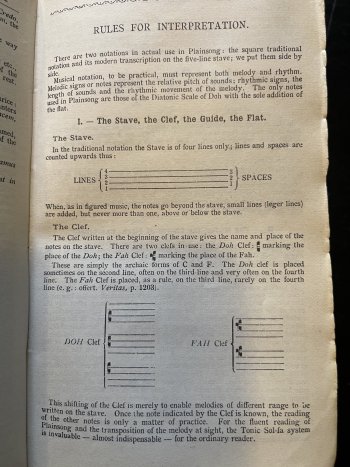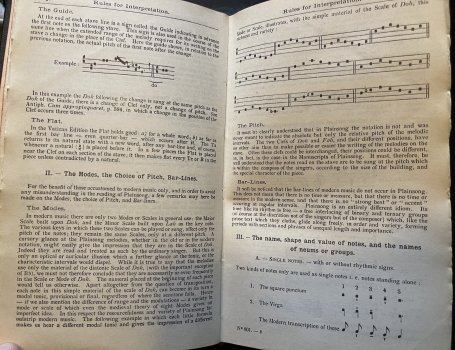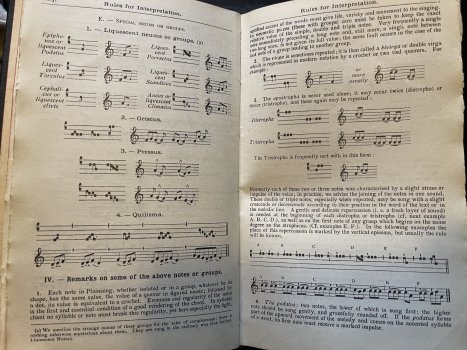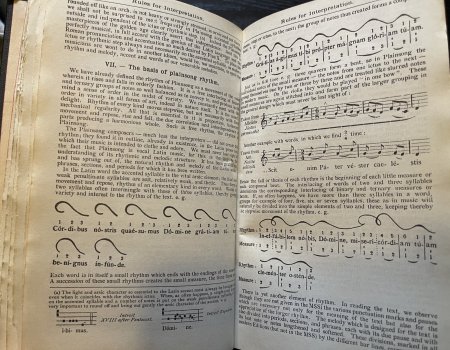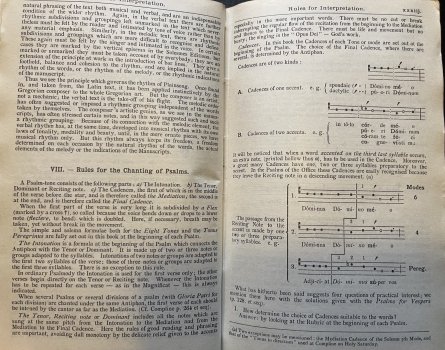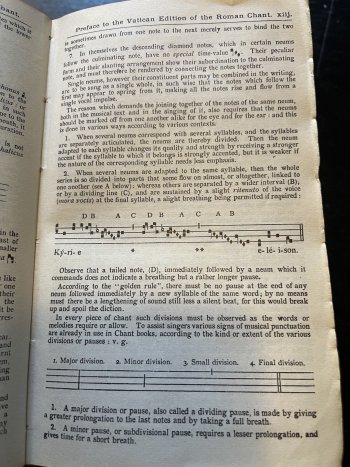Terrific post; who dares to say that medieval manuscripts have no relevance in the modern age? Not I.That’s actually a lovely connection I didn’t make. I read somewhere that marginalia was actually a mnemonic method, a sort of aide to create a memory palace and that using “shocking” images made the effort easier. Some of them are indeed interesting:
This is the only way I can memorize a text:
View attachment 2096669
As a person that suffers from strong migraines, I can relate to this clearly advanced medical and natural cure:
View attachment 2096670
Finding a good, reliable babysitter has always been a struggle. Here’s a reminder of how the best babysitters present themselves:
View attachment 2096671
No electricity or gas this winter? Problem solved.
View attachment 2096672
As for the cat, I am not joking that he kept his paw on that page, however he moved it a few times. After the reading session - and my praise of His Majesty the cat - I actually gave him the tuna treat.
Got a tip for us?
Let us know
Become a MacRumors Supporter for $50/year with no ads, ability to filter front page stories, and private forums.
Spoilers What Book Are You Reading?
- Thread starter Huntn
- Start date
- Sort by reaction score
You are using an out of date browser. It may not display this or other websites correctly.
You should upgrade or use an alternative browser.
You should upgrade or use an alternative browser.
Sometimes when I look at my cheap, $1 copy of some work such as Marcus Aurelius’ Meditations, or Socrates’ Dialogues, or St Augustine etc, I ponder how much work it took for those works to come to me. I pay $1, or less than $10. And yet, hundreds of people through the centuries had to manually copy it, with meticulous effort and love, often defending their work from all sort of attacks, from actual warfare to pestilences and any kind of poverty. It’s just incredible what people did to preserve thought, something that shouldn’t be taken for granted.Terrific post; who dares to say that medieval manuscripts have no relevance in the modern age? Not I.
On the other hand….
The Exorcist (1971) by Peter William Blatty.
October means horror movies and at least a horror novel. While browsing some movie to watch, I realized that I haven’t watched The Exorcist in about a quarter of a century. Even more troubling, I realized that I have never read the book.
Blatty’s book is outstanding, terrifying, and it holds the test of time. Father Karras is incredibly well developed, and so his relations with the other characters. Most of us know the story from the movie, but I can’t recommend reading this book strongly enough. I expect to watch the movie this weekend, and I expect that I’ll read Blatty’s sequel, “Legion”.

October means horror movies and at least a horror novel. While browsing some movie to watch, I realized that I haven’t watched The Exorcist in about a quarter of a century. Even more troubling, I realized that I have never read the book.
Blatty’s book is outstanding, terrifying, and it holds the test of time. Father Karras is incredibly well developed, and so his relations with the other characters. Most of us know the story from the movie, but I can’t recommend reading this book strongly enough. I expect to watch the movie this weekend, and I expect that I’ll read Blatty’s sequel, “Legion”.
Agreed.Sometimes when I look at my cheap, $1 copy of some work such as Marcus Aurelius’ Meditations, or Socrates’ Dialogues, or St Augustine etc, I ponder how much work it took for those works to come to me. I pay $1, or less than $10. And yet, hundreds of people through the centuries had to manually copy it, with meticulous effort and love, often defending their work from all sort of attacks, from actual warfare to pestilences and any kind of poverty. It’s just incredible what people did to preserve thought, something that shouldn’t be taken for granted.
On the other hand….
View attachment 2097061
Preserving thought - and knowledge - and sources of thought and knowledge and learning - (sometimes against appalling odds) is something to be applauded, cherished, treasured and passionately supported.
Well, we all have different red lines, but this is one of mine.
I finished "The Martian" by Andy Weir. . I enjoy science fiction books that are based in reality, and "The Martian" does a great job of presenting a believable scenario. The characters are well-developed and the plot is thrilling. Thanks for your opinions. I'll try to choose next one)
I love that book!I finished "The Martian" by Andy Weir. . I enjoy science fiction books that are based in reality, and "The Martian" does a great job of presenting a believable scenario. The characters are well-developed and the plot is thrilling. Thanks for your opinions. I'll try to choose next one)
Check out his latest novel too!

Not being Christian I laughed my butt off when I first saw it. Very good effects for the time.The Exorcist (1971) by Peter William Blatty.
October means horror movies and at least a horror novel. While browsing some movie to watch, I realized that I haven’t watched The Exorcist in about a quarter of a century. Even more troubling, I realized that I have never read the book.
Blatty’s book is outstanding, terrifying, and it holds the test of time. Father Karras is incredibly well developed, and so his relations with the other characters. Most of us know the story from the movie, but I can’t recommend reading this book strongly enough. I expect to watch the movie this weekend, and I expect that I’ll read Blatty’s sequel, “Legion”.
View attachment 2097275
thanks, I'll check))I love that book!
Check out his latest novel too!

Liber Usualis (1896).
As Monty Python said, and now for something completely different I am going to continue the series on breviaries. I previously discussed the Monastic Diurnal, Monastic Matins, the Eastern Anthologion, and the Anglican Book of Common Prayer of 1979.
This time the post will need many pictures (I will put some under the spoiler tag to avoid filling screens) and will include YouTube links because… we’re going to talk about music using a book of which my copy was printed in 1938.
Basic Facts
In the classical view, and in many movies, the image of a church or monastery is often accompanied by soft chanting; this chant is more likely than not a Gregorian chant. Gregorian music developed in the IX century and likely began its formalization under Pope Gregory I, not to be confused with Gregory XIII which in the XVI century gave us the current calendar.
Gregorian chants are traditionally sung without any accompaniment, however more modern versions include organ and piano, and in case of the pop band Gregorian, they even include electric guitar and synthesizers to reinterpret popular songs using Gregorian tones. Since I am not a musician, I will not discuss any of the technical features, however it’s impossible to ignore the importance that Gregorian chants - and their standardization - had on the history of music.
The Book
By the XIX century, liturgical functions became very complex. Between pontifical masses, daily divine office, octaves and such, the need for an encyclopedia of chant was needed. Some monks in France took action and developed the current form of the Liber Usualis, a 2000 page thick book meant to include all the fascinating music and tones that would be used at all sorts of events, from masses to funerals, from baptisms to psalm prayer.
The work is of massive proportions, meticulous in its explanations and in its functionality. It’s a sort of book editing miracle which became very popular and was widely used at monasteries around the world.
Here’s the cover and the first page of the Belgium 1938 print:
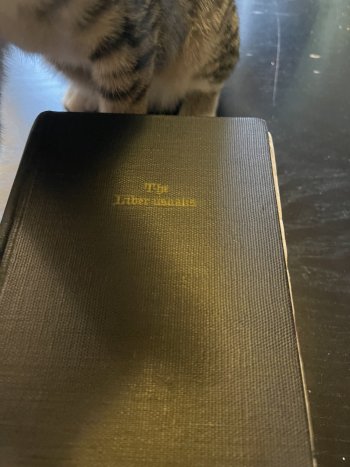

A look at its contents
A quick glance at the index will clarify immediately that this book contains virtually everything.
Of striking importance is the fact that the book teaches the reader how to read Gregorian notation and how to sing it, breathing included. A couple pics in clear, a few more under spoiler tags.

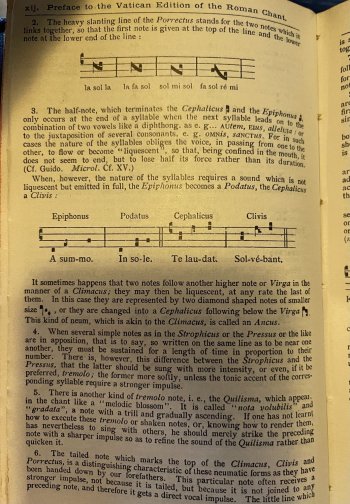
The calendar. No respectable liturgical book would skip a good, complex calendar. Here’s the one in my edition which is the old pre-reform calendar.

Now, the reader/singer/celebrant would need to carefully check the calendar against the office of the day and select the proper chants and liturgy. Here’s the meat of the book, the actual music. Notice the eight tones for the Hallelujah.
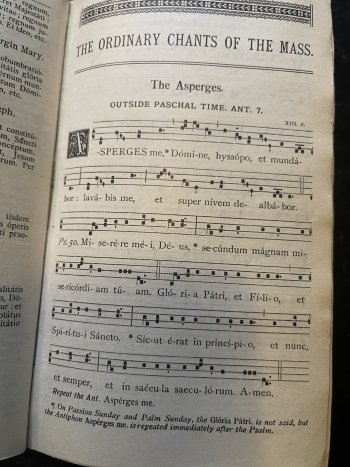


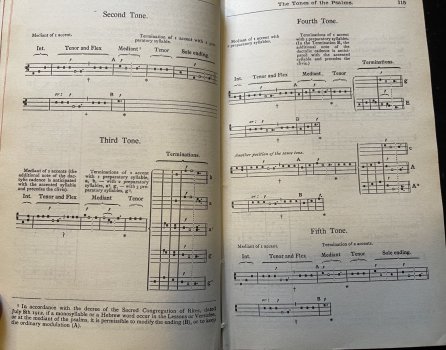
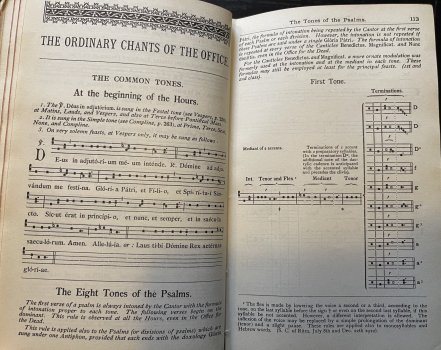
Another feat is the presence of lectionaries (basically, the various readings). Here’s a Holy Week not-so-short reading:
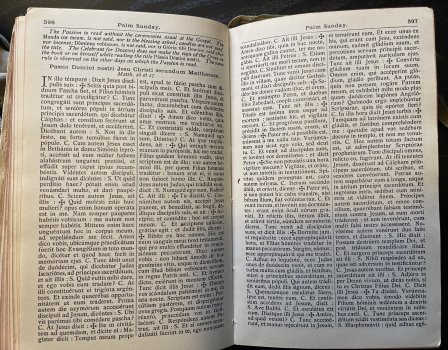
and here are some readings within the chant section.
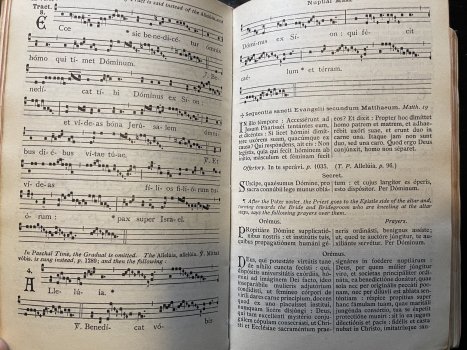
There is much more to talk about this book but I probably annoyed everyone by now.
I’ll close the pictures section by giving you an idea of how thick this book is:

Now, to conclude in style… what does this work of love actually amounts to? Amazing chant. If you want to listen to the product of those pages, here a few examples taken directly from this book that you can follow along.
Here’s the Salve Regina, which to my inexperienced ears sounds very modern:
And here’s how two different tones affect the same chant, in this case Ave Regina in Simple tone and solemn tone:
-I love books.
As Monty Python said, and now for something completely different I am going to continue the series on breviaries. I previously discussed the Monastic Diurnal, Monastic Matins, the Eastern Anthologion, and the Anglican Book of Common Prayer of 1979.
This time the post will need many pictures (I will put some under the spoiler tag to avoid filling screens) and will include YouTube links because… we’re going to talk about music using a book of which my copy was printed in 1938.
Basic Facts
In the classical view, and in many movies, the image of a church or monastery is often accompanied by soft chanting; this chant is more likely than not a Gregorian chant. Gregorian music developed in the IX century and likely began its formalization under Pope Gregory I, not to be confused with Gregory XIII which in the XVI century gave us the current calendar.
Gregorian chants are traditionally sung without any accompaniment, however more modern versions include organ and piano, and in case of the pop band Gregorian, they even include electric guitar and synthesizers to reinterpret popular songs using Gregorian tones. Since I am not a musician, I will not discuss any of the technical features, however it’s impossible to ignore the importance that Gregorian chants - and their standardization - had on the history of music.
The Book
By the XIX century, liturgical functions became very complex. Between pontifical masses, daily divine office, octaves and such, the need for an encyclopedia of chant was needed. Some monks in France took action and developed the current form of the Liber Usualis, a 2000 page thick book meant to include all the fascinating music and tones that would be used at all sorts of events, from masses to funerals, from baptisms to psalm prayer.
The work is of massive proportions, meticulous in its explanations and in its functionality. It’s a sort of book editing miracle which became very popular and was widely used at monasteries around the world.
Here’s the cover and the first page of the Belgium 1938 print:


A look at its contents
A quick glance at the index will clarify immediately that this book contains virtually everything.
Of striking importance is the fact that the book teaches the reader how to read Gregorian notation and how to sing it, breathing included. A couple pics in clear, a few more under spoiler tags.


The calendar. No respectable liturgical book would skip a good, complex calendar. Here’s the one in my edition which is the old pre-reform calendar.

Now, the reader/singer/celebrant would need to carefully check the calendar against the office of the day and select the proper chants and liturgy. Here’s the meat of the book, the actual music. Notice the eight tones for the Hallelujah.





Another feat is the presence of lectionaries (basically, the various readings). Here’s a Holy Week not-so-short reading:

and here are some readings within the chant section.

There is much more to talk about this book but I probably annoyed everyone by now.
I’ll close the pictures section by giving you an idea of how thick this book is:

Now, to conclude in style… what does this work of love actually amounts to? Amazing chant. If you want to listen to the product of those pages, here a few examples taken directly from this book that you can follow along.
Here’s the Salve Regina, which to my inexperienced ears sounds very modern:
And here’s how two different tones affect the same chant, in this case Ave Regina in Simple tone and solemn tone:
-I love books.
Last edited:
The book in my opinion is more disturbing than the movie. Of course when I watched it as a child I was terrified by it.Not being Christian I laughed my butt off when I first saw it. Very good effects for the time.
Yeah, I get that. I don't think that was a children's movie. I never read the book but I can imagine that the added detail made it more terrifying.The book in my opinion is more disturbing than the movie. Of course when I watched it as a child I was terrified by it.
Currently Reading
Coyote Waits
by Tony Hillerman
I have not read his books in order but I do like the Chee/Leaphorn dynamic. I am on my fifth one out of many but hopefully I can read them all including his daughter's continuation.
Coyote Waits
by Tony Hillerman
I have not read his books in order but I do like the Chee/Leaphorn dynamic. I am on my fifth one out of many but hopefully I can read them all including his daughter's continuation.
Just finished the unabridged version of 11/23/63, Just over 1200 pages... good lord, there were times I wanted to pull my hair out. However, it all paid off and this is one of the endings I actually liked by King. After reading the ending the Epilogue, it seems this version had a different ending than the original version and this version was his son's idea. I liked it and I liked it a lot.
So now I am looking for the next book.
So now I am looking for the next book.
The Pale King.
Is this by David Foster Wallace? If so I have added it to my queue..!
Yes. It’s unfinished. Let’s say without spoilers that it deals with IRS employees, old local planning maps, tax code, and other frustrating things. Brutal.Is this by David Foster Wallace? If so I have added it to my queue..!
Legion (1983) by William Peter Blatty.
Several years after the events narrated in The Exorcist, good old detective Lieutenant Kinderman has to face new threats in the form of the Gemini killer.
Usually sequels are pretty bad, but I thoroughly enjoyed this one. It’s more on the thriller detective story than the previous one but the story and the characters are quite enjoyable. Certainly not as disruptive as The Exorcist, it’s definitely a great follow up.
Note: as for the movies go, Legion applies to The Exorcist III and not The Exorcist II (which is crappy).

Several years after the events narrated in The Exorcist, good old detective Lieutenant Kinderman has to face new threats in the form of the Gemini killer.
Usually sequels are pretty bad, but I thoroughly enjoyed this one. It’s more on the thriller detective story than the previous one but the story and the characters are quite enjoyable. Certainly not as disruptive as The Exorcist, it’s definitely a great follow up.
Note: as for the movies go, Legion applies to The Exorcist III and not The Exorcist II (which is crappy).
I love that book!
Check out his latest novel too!

Not sure if you've read it already but I thoroughly enjoyed Dark Matter by Blake Crouch
Dark Matter was excellent!. I'm currently chewing through:Not sure if you've read it already but I thoroughly enjoyed Dark Matter by Blake Crouch
View attachment 2108152
Waiting for my girlfriend to finish it so I can get my hands on it!
You won't have to wait long. Although not quite the page turner that Dark Matter was, the pacing and structure means she will likely tear through it quickly. I read Dark Matter over a long weekend - I never read books that quickly!Waiting for my girlfriend to finish it so I can get my hands on it!
btw - great choice of car. I bought one of the first bug-eyed WRX's in the US (a WR Rally Blue 2002 WRX). I kept the car for the best part of a decade and drove the wheels off it. Bug-eyes were the best! (Never owned an STi though.)
The Age of Insight by Eric Kandel
"A brilliant book by Nobel Prize winner Eric R. Kandel, The Age of Insight takes us to Vienna 1900, where leaders in science, medicine, and art began a revolution that changed forever how we think about the human mind—our conscious and unconscious thoughts and emotions—and how mind and brain relate to art."
"A brilliant book by Nobel Prize winner Eric R. Kandel, The Age of Insight takes us to Vienna 1900, where leaders in science, medicine, and art began a revolution that changed forever how we think about the human mind—our conscious and unconscious thoughts and emotions—and how mind and brain relate to art."
As an Amazon Associate, MacRumors earns a commission from qualifying purchases made through links in this post.
The Age of Insight by Eric Kandel
"A brilliant book by Nobel Prize winner Eric R. Kandel, The Age of Insight takes us to Vienna 1900, where leaders in science, medicine, and art began a revolution that changed forever how we think about the human mind—our conscious and unconscious thoughts and emotions—and how mind and brain relate to art."
And to think that this amazing, brilliant, scintillating, extraordinary world - attractive, cosmopolitan, questioning, sophisticated - died in 1914.
As an Amazon Associate, MacRumors earns a commission from qualifying purchases made through links in this post.
Register on MacRumors! This sidebar will go away, and you'll see fewer ads.



